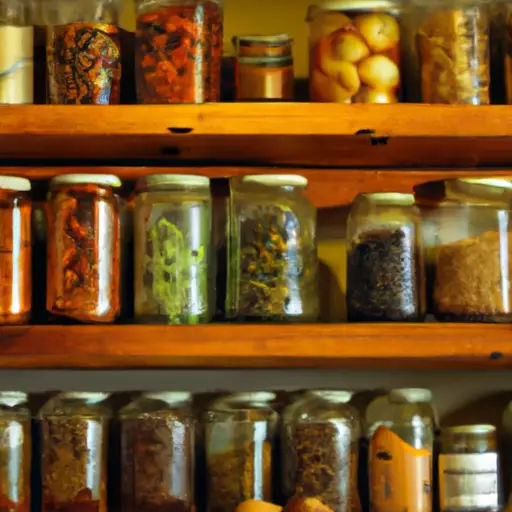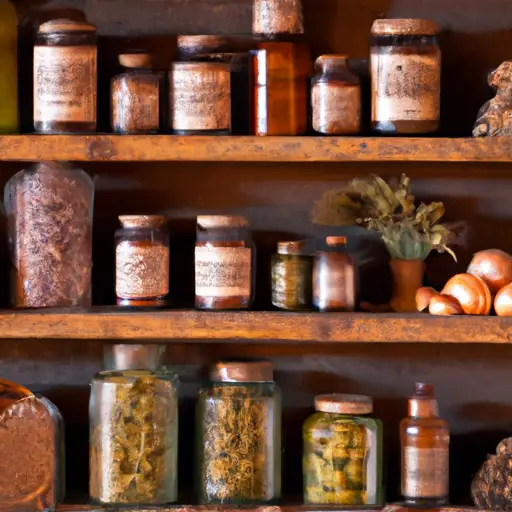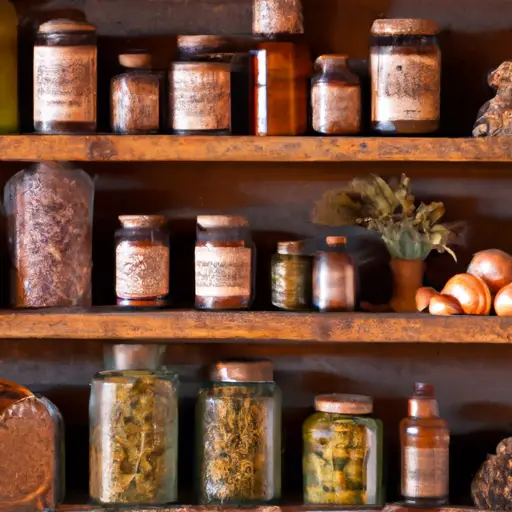So, have you ever wondered how people managed to store their food before the invention of refrigerators? I mean, nowadays we pop our leftovers in the fridge without even giving it a second thought, but back in the day, things were a little different. Well, let me tell you, our ancestors had some pretty ingenious methods for food storage. In fact, they had been preserving their food long before fridges were even a thing. Want to know more? Well, keep on reading and I’ll fill you in on the fascinating history of food storage before refrigerators.
Before refrigerators came along, people had to get creative to keep their food from spoiling. They relied on various techniques, such as drying, salting, smoking, pickling, and fermenting, just to name a few. These methods allowed them to preserve different types of food for extended periods of time. Can you imagine having to salt your meat to preserve it, or ferment your cabbage to make sauerkraut? It’s crazy to think about how much effort they had to put into keeping their food safe to eat.
In ancient times, people often stored their food in cool places, like caves or cellars, to slow down the spoilage process. They also used ice and snow to keep their food chilled. Yeah, that’s right, ice and snow! They would gather ice during the winter and store it in ice houses, insulated with straw or sawdust, to use throughout the year. And for those living in warmer climates, they had to get really creative. Some cultures used ceramic containers that were partially submerged in water, which then evaporated and created a cooling effect. Pretty cool, huh? And that’s just scratching the surface of the fascinating history of food storage. So, if you want to learn more about this topic, be sure to check out the full article.

Introduction
Before the invention of refrigerators, people had to rely on various methods to store and preserve their food. These methods ranged from drying and smoking to fermentation, canning, and the use of salt. In this article, we will explore the different techniques that were used throughout history to keep food fresh and edible for extended periods of time.
Early Methods of Food Storage
Drying
One of the earliest methods of food storage is drying. By removing moisture from food, the growth of bacteria and other microorganisms is inhibited, allowing the food to be stored for longer periods without spoiling. In ancient times, people would dry food by laying it out in the sun or using smoke from a fire. This technique was commonly used for fruits, vegetables, and even meat.
Smoking
Smoking is another effective method of preserving food. By exposing food to smoke from burning wood, the heat and chemicals in the smoke prevent the growth of bacteria while infusing the food with a distinct smoky flavor. This technique was particularly popular for preserving meat and fish, as the smoke acted as a preservative while also adding flavor.
Salting and Curing
Salt has long been used as a preservative for food. By applying a generous amount of salt to food, moisture is drawn out, making it difficult for bacteria to multiply. Salt can also prevent the growth of certain types of harmful bacteria and fungi. Salted and cured foods, such as salted fish, bacon, and ham, were commonly prepared to ensure a stable food supply throughout the year.
Underground Storage Techniques
Root Cellars
Before refrigeration, root cellars were commonly used to store root vegetables, fruits, and other perishable foods. These underground storage areas provided a cool and dark environment, which helped to slow down the process of food spoilage. Root cellars were commonly built with thick walls and ventilation systems to regulate temperature and humidity levels.
Ice Houses
In regions with colder climates, ice houses were used to store food for extended periods. These structures were built with thick walls and insulation to keep the interior cool during the warmer months. During winter, ice would be collected from frozen lakes and stored in the ice house. The ice would then be used throughout the year to keep food chilled and prevent spoilage.
Pits and Caches
In areas where the ground remained frozen for most of the year, pits and caches were dug to store food. These pits would be lined with insulating materials such as straw, branches, or animal skins to help maintain a consistent temperature. Food, such as meat, fish, and even grains, would be stored in these pits to protect it from animals and spoilage.

Preservation with Fermentation
Fermented Vegetables
Fermentation is a process that involves the conversion of sugars into alcohol or other organic compounds by the action of bacteria or yeast. Fermented vegetables, such as sauerkraut and pickles, were popular methods of food preservation before refrigeration. Through the fermentation process, beneficial bacteria break down the sugars in the vegetables, producing lactic acid, which acts as a natural preservative.
Pickling
Pickling is another type of fermentation that involves preserving food in an acidic solution, usually vinegar or brine. By immersing vegetables or fruits in this solution, the growth of harmful bacteria is inhibited, allowing the food to be stored for longer periods. Pickled foods can be made by adding various spices and herbs to enhance flavor.
Sauerkraut and Kimchi
Sauerkraut and kimchi are two examples of fermented foods that have been enjoyed for centuries. Sauerkraut is made from fermented cabbage, while kimchi is a Korean dish made from fermented vegetables, such as cabbage, radishes, and cucumbers. Both of these dishes are rich in probiotics, which are beneficial for gut health, as well as being effective methods of food preservation.
Canning and Bottling
The Origins of Canning
The technique of canning, which involves sealing food in airtight containers, dates back to the late 18th century. It was developed as a response to the need for preserved food during long sea voyages. Napoleon Bonaparte offered a cash prize to anyone who could develop a method to safely preserve food for his army, which ultimately led to the invention of canning.
Napoleon’s Influence
Napoleon’s influence on food preservation cannot be overstated. His desire for a stable food supply for his troops spurred innovation in food preservation techniques. Canning, under Napoleon’s leadership, became a widely used method of preserving food, improving the accessibility and quality of preserved food for both military and civilian purposes.
The Mason Jar Invention
In 1858, John Mason invented the Mason Jar, a glass jar with a screw-on lid that revolutionized home canning. This invention made it easier for individuals to preserve their own food at home, extending its shelf life and reducing dependence on commercial products. Mason jars are still widely used today for preserving jams, pickles, and other homemade foods.
Preservation with Salt
Salt as a Preservative
Salt has been used for centuries as a preservative due to its ability to draw water out of food and inhibit the growth of bacteria. In ancient civilizations such as Egypt, salt was highly valued and used to preserve fish, meat, and vegetables. Salt would be rubbed onto the food, creating a hostile environment for bacteria and preventing spoilage.
Salted Fish and Meats
One of the most well-known methods of preserving food with salt is the salting of fish and meats. Salting fish, such as cod or herring, involves covering the fish in a layer of salt and allowing it to dry. The salt dehydrates the fish, making it inhospitable to bacteria and allowing it to be stored for extended periods. Similarly, various cuts of meat would be salted and dried to create products like jerky or salt pork.
Food Preservation in Ancient Civilizations
The use of salt for food preservation can be traced back to ancient civilizations such as the Egyptians, Greeks, and Romans. These civilizations recognized the importance of salt in preserving food and would use it not only for meat and fish but also for fruits and vegetables. By drying and salting these foods, they were able to sustain themselves during times of scarcity.
The Rise of Iceboxes
Icebox Invention
As the need for food storage and preservation grew, the icebox was developed in the mid-19th century. The icebox was essentially an insulated wooden box with a compartment for storing ice. The ice would be placed in the top compartment, while the lower compartment would hold the perishable items. The ice would gradually melt, cool the interior, and extend the shelf life of the food.
Ice Blocks and Delivery
To supply the demand for ice, a thriving ice industry developed in the 19th century. Large blocks of ice would be harvested from frozen lakes and rivers during winter, stored in icehouses, and then delivered to households and businesses. The ice would be carefully packed and covered in sawdust or straw to slow down melting during transportation.
The Ice Trade
The ice trade became a significant industry, with ice being shipped by rail and boat to both urban and rural areas. Ice became a commodity that enabled people to keep their perishable food fresh for longer periods. However, the reliance on the ice trade also meant that access to ice was not universal, and those living in more remote areas had to rely on alternative preservation methods.
The Evolution of Refrigeration
Mechanical Refrigeration
The invention of mechanical refrigeration in the late 19th century brought about a revolutionary change in food storage. With the introduction of refrigeration units, a constant and adjustable cooling environment was made available to households and businesses. This allowed for more precise temperature control and longer-lasting food preservation.
Commercial Refrigeration
As refrigeration technology advanced, commercial applications became more common. Grocery stores, restaurants, and other businesses began using large-scale refrigeration units to store and display perishable items. This enabled the availability of fresh produce year-round, greatly impacting food distribution and consumption patterns.
Home Refrigerators
The introduction of home refrigerators in the early 20th century transformed how people stored and preserved food. This appliance provided households with the convenience of storing perishable items for longer periods, reducing the need for frequent grocery shopping and waste. The refrigerator became a staple in kitchens around the world, improving food safety and accessibility.
Modern Food Storage Innovations
Vacuum Sealing
Vacuum sealing is a modern method of food storage that involves removing air from a package before sealing it. By eliminating the presence of oxygen, the growth of bacteria and other spoilage-causing microorganisms is greatly reduced. Vacuum-sealed foods can be stored for extended periods without the need for refrigeration.
Modified Atmosphere Packaging
Modified Atmosphere Packaging (MAP) is a technique used to extend the shelf life of perishable foods. It involves modifying the atmosphere inside the package by replacing the air with a gas mixture that inhibits bacterial growth. MAP is commonly used for packaging fresh produce, meat, and baked goods.
Refrigeration Technology Advancements
Refrigeration technology continues to advance, allowing for more energy-efficient and environmentally friendly cooling systems. Newer refrigerators are equipped with features such as smart temperature control, humidity sensors, and improved insulation. These advancements help to preserve food quality and reduce energy consumption.
Conclusion
The history of food storage before refrigerators is a testament to human innovation and ingenuity. From drying and smoking to fermentation, canning, and the use of salt, our ancestors developed various techniques to preserve their food for long periods. The invention and subsequent evolution of refrigeration drastically changed how we store and preserve food, improving food safety, accessibility, and reducing food waste. Today, we continue to rely on modern food storage innovations to ensure a stable and reliable food supply.




